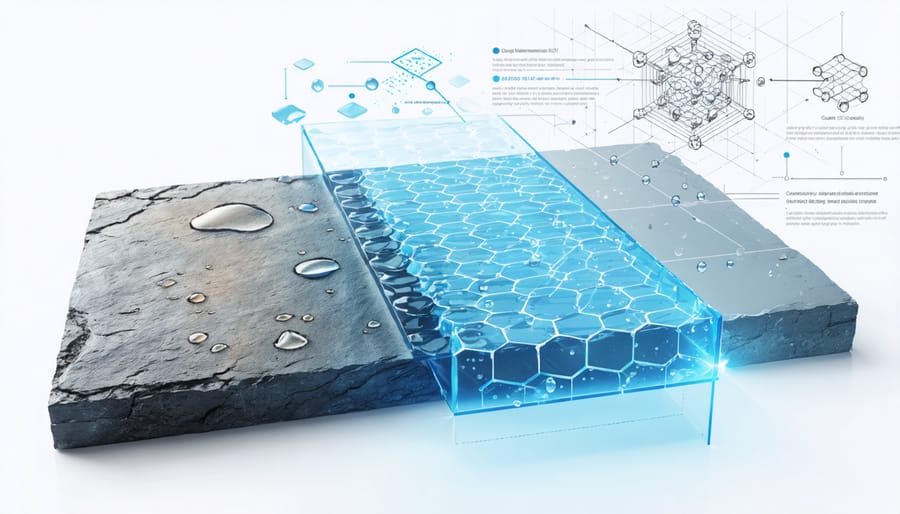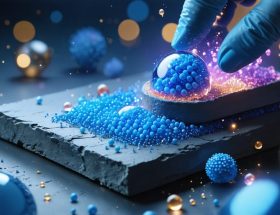At the intersection of quantum mechanics and modern stone technology, quantum nanotechnology represents a revolutionary breakthrough in surface protection. This innovative approach manipulates matter at the atomic level, creating protective barriers that conform perfectly to stone’s microscopic structure.
By harnessing quantum effects, these nano-scale treatments establish molecular bonds that penetrate deeper than conventional sealers, offering unprecedented protection against moisture, staining, and environmental damage. The technology’s quantum properties enable self-organizing particles to adapt to various stone compositions, ensuring optimal coverage and longevity.
Unlike traditional surface treatments, quantum nanotechnology creates a breathable barrier that maintains the stone’s natural characteristics while providing superior protection. This advancement marks a significant shift in stone preservation, offering architects, designers, and property owners a scientifically advanced solution that combines durability with aesthetic preservation.
The practical implications are remarkable: enhanced stain resistance, reduced maintenance requirements, and extended material lifespan, all while maintaining the stone’s natural beauty and authenticity. This breakthrough represents the future of stone protection, where quantum science meets practical application in architectural preservation.
How Quantum Nanotechnology Works in Stone Protection
The Quantum Scale Advantage
The effectiveness of quantum-scale treatments lies in their ability to work at the molecular level, where stone’s protective needs truly begin. Unlike traditional sealers that merely coat the surface, quantum nanotechnology integrates with the stone’s crystalline structure, creating a substantially more resilient barrier against stains and damage. This breakthrough approach, which aligns with other emerging stone fabrication techniques, operates at scales thousands of times smaller than conventional treatments.
At the quantum level, protective particles can penetrate deeper into the stone’s microscopic pores, establishing a more comprehensive shield against moisture and contaminants. These nano-sized particles form chemical bonds with the stone’s natural structure, creating a protective network that becomes part of the material itself rather than sitting as a separate layer on top.
This molecular-level integration results in longer-lasting protection that doesn’t alter the stone’s natural appearance or texture. The quantum advantage also means that less product is needed for effective coverage, as each particle works more efficiently at this scale. The treatment’s ability to maintain the stone’s breathability while providing superior protection represents a significant advancement over traditional sealing methods, offering both improved performance and sustainability.
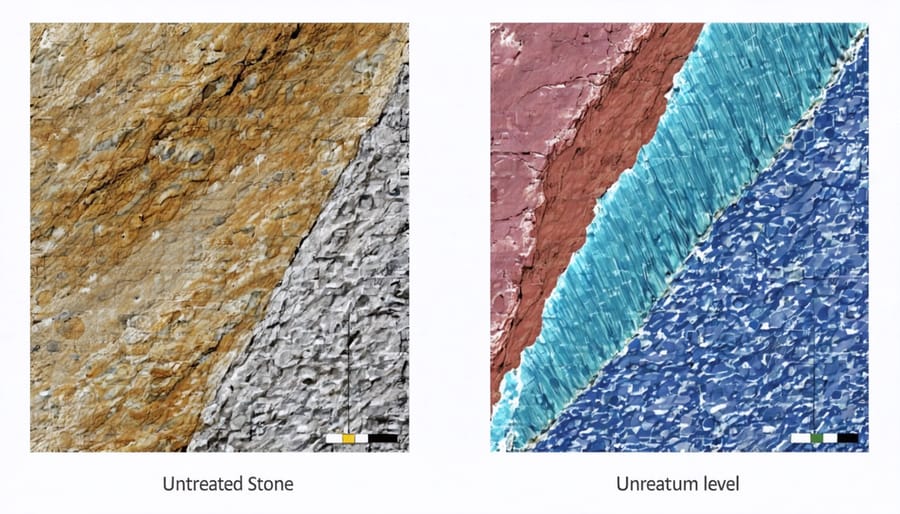
Self-Assembling Nanoparticles
Self-assembling nanoparticles represent a groundbreaking advancement in stone protection technology, operating at the molecular level to create robust defensive barriers. These intelligent particles work through a process called molecular self-organization, where they automatically arrange themselves into precise patterns when applied to stone surfaces.
When the nanoparticle solution contacts the stone, the particles begin aligning themselves based on their electromagnetic properties. This creates an invisible yet highly effective protective layer that bonds directly with the stone’s molecular structure. The particles organize themselves in a way that maximizes surface coverage while maintaining the stone’s natural appearance and breathability.
The self-assembly process is particularly effective because it ensures complete and uniform coverage, even in microscopic pores and crevices that traditional sealers might miss. These nanoparticles create multiple layers of protection, with each layer serving a specific purpose – some repel water, others block UV radiation, while additional layers prevent chemical damage.
What makes this technology truly remarkable is its adaptive nature. The nanoparticles can reorganize themselves in response to environmental changes or damage, maintaining the protective barrier’s integrity over time. This self-healing capability significantly extends the longevity of the treatment compared to conventional sealers.
For stone professionals and property owners, this means more reliable and longer-lasting protection without the need for frequent reapplication, ultimately reducing maintenance costs while providing superior protection.
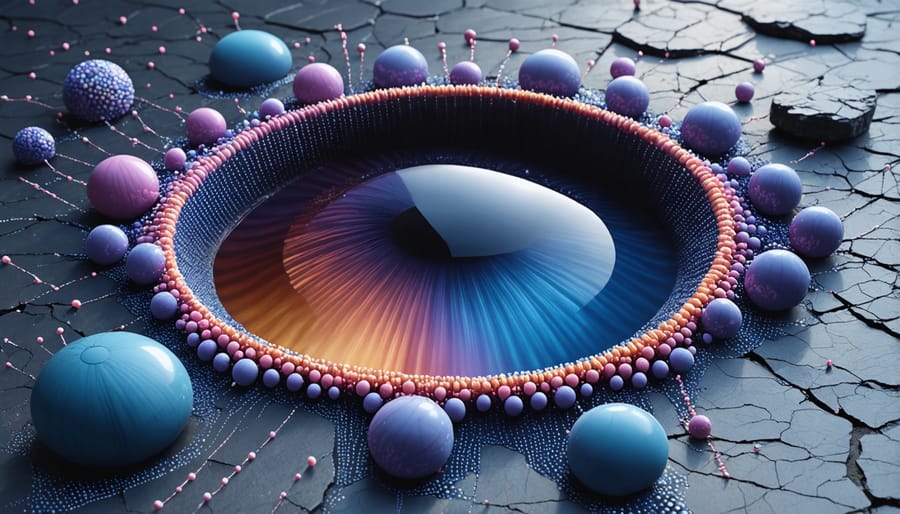
Real-World Benefits for Stone Surfaces
Enhanced Stain Resistance
Quantum nanotechnology revolutionizes stain resistance by creating an invisible molecular barrier that actively repels both water-based and oil-based contaminants. Using advanced stone treatment visualization, we can observe how these nano-particles bond with the stone’s surface at a microscopic level, filling natural pores and imperfections without altering the material’s appearance or texture.
Unlike traditional sealers that simply coat the surface, quantum treatments work by creating a reactive barrier that prevents staining agents from penetrating the stone. The nano-particles establish a permanent molecular structure that maintains flexibility while providing superior protection. This quantum-level defense system actively repels common substances like wine, coffee, oils, and acidic solutions before they can settle into the stone’s pores.
The treatment’s effectiveness stems from its ability to maintain the stone’s natural breathability while creating an exceptionally durable barrier. This molecular engineering ensures that spills bead up on the surface, allowing for easy cleanup without the risk of permanent staining. The protection remains stable and active for years, significantly reducing maintenance requirements while preserving the stone’s natural beauty.
Superior Water Repellency
The quantum nanotechnology treatment creates an exceptionally water-repellent surface through a sophisticated molecular arrangement. When applied to natural stone, it forms an invisible protective barrier that mimics the microscopic structure found in naturally water-resistant surfaces like lotus leaves. This phenomenon, known as the lotus effect, occurs when water droplets maintain their surface tension and form perfect spheres that roll off the surface, carrying dirt and debris with them.
The treatment achieves this by creating a network of nano-sized particles that bond with the stone’s surface at a molecular level. These particles arrange themselves in a precise pattern that increases the contact angle between water droplets and the surface to over 140 degrees. This enhanced angle prevents water from spreading and instead causes it to bead up and roll away.
Unlike traditional sealers that merely coat the surface, quantum nanotechnology penetrates the stone’s pores while maintaining its natural breathability. This results in superior water repellency that lasts significantly longer than conventional treatments, protecting the stone from water damage, staining, and deterioration.
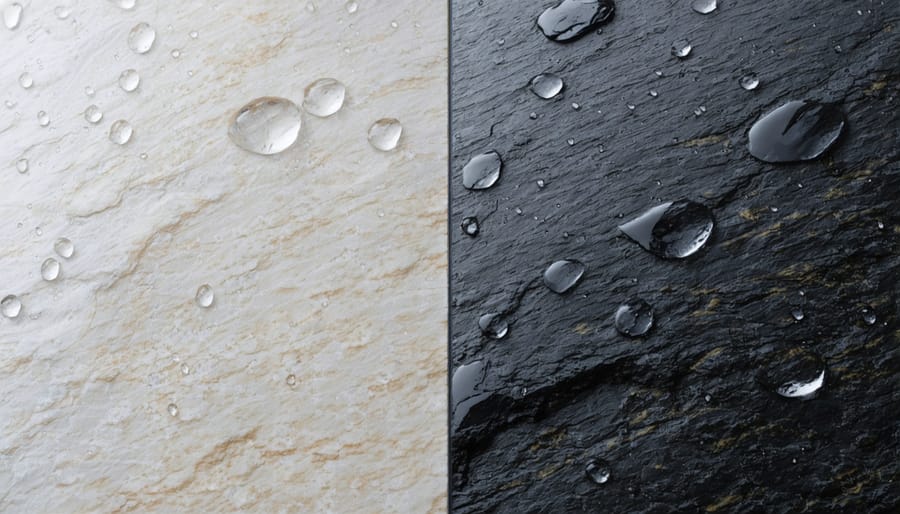
Extended Surface Life
Quantum nanotechnology treatments create an exceptionally durable protective barrier that significantly extends the life of natural stone surfaces. Unlike traditional sealers that deteriorate within 1-2 years, these advanced treatments typically maintain their effectiveness for 5-10 years, dramatically reducing the need for frequent reapplication and maintenance.
The molecular-level bonding process creates a permanent shield against stains, etching, and weathering, while allowing the stone to maintain its natural breathing properties. This enhanced protection means surfaces require less frequent cleaning and are more resistant to harsh environmental conditions, including UV exposure and freeze-thaw cycles.
Building owners and facility managers report up to 70% reduction in maintenance costs after applying quantum nanotechnology treatments. The long-term protection eliminates the need for aggressive cleaning chemicals and reduces the frequency of professional restoration services. This not only preserves the stone’s natural beauty but also provides significant cost savings over the surface’s lifetime.
For historic buildings and high-traffic commercial spaces, this extended protection period offers a practical solution to preserve architectural elements while minimizing disruption from maintenance activities.
Environmental Impact
Quantum nanotechnology represents a significant advancement in environmentally conscious stone treatment solutions. Unlike traditional sealers that often contain harmful volatile organic compounds (VOCs), quantum nanotech treatments utilize eco-friendly molecular structures that minimize environmental impact. These treatments align perfectly with modern sustainable stone practices while delivering superior protection.
The manufacturing process requires minimal energy consumption compared to conventional sealers, and the treatments themselves produce zero toxic byproducts. Because quantum nanotech solutions are highly efficient, less product is needed to achieve optimal results, reducing waste and environmental footprint. Additionally, their long-lasting nature means fewer reapplications are necessary over time, further decreasing the overall environmental impact of stone maintenance.
Perhaps most importantly, these treatments are water-based and biodegradable, ensuring they don’t contribute to groundwater contamination or soil pollution when eventually broken down. This eco-conscious approach to stone protection demonstrates how cutting-edge technology can enhance both performance and environmental stewardship in the stone industry.
Application and Maintenance
Professional Application Process
To achieve optimal results with quantum nanotechnology treatments, follow these essential application steps. First, thoroughly clean the stone surface using a pH-neutral cleaner and allow it to dry completely for at least 24 hours. Any residual moisture can interfere with the quantum bonding process.
Before application, ensure the ambient temperature is between 50-85°F (10-29°C) with relative humidity below 85%. Using proper protective equipment, including gloves and respiratory protection, apply the treatment in thin, even coats using a low-pressure sprayer or microfiber applicator.
Work in manageable sections of approximately 40-50 square feet at a time, maintaining a wet edge to prevent lap marks. Allow the first coat to penetrate for 10-15 minutes, then apply a second coat while the surface is still slightly damp. Remove any excess product with a clean, lint-free cloth to prevent residue formation.
The treated surface should be protected from water contact for at least 12 hours and foot traffic for 24 hours. Full curing and optimal protection typically develop within 7 days. For exterior applications, check weather forecasts to ensure no rain is expected for at least 24 hours after treatment.
Document the application date and maintain detailed records for warranty purposes and future maintenance scheduling. Regular inspection of treated surfaces helps monitor protection levels and determine when reapplication may be necessary.
Long-term Care Guidelines
To maintain the effectiveness of quantum nanotechnology treatments on stone surfaces, regular monitoring and proper care are essential. Clean treated surfaces using pH-neutral cleaners specifically formulated for natural stone. Avoid acidic or harsh chemical cleaners, as these can compromise the quantum nanostructure and reduce its protective capabilities.
Inspect treated surfaces quarterly for signs of wear or degradation. Look for changes in water beading behavior, which may indicate the treatment is beginning to wear off. In high-traffic areas or surfaces exposed to extreme conditions, inspections should be conducted more frequently.
Professional reapplication is recommended every 3-5 years, depending on environmental factors and usage patterns. However, indoor applications in moderate conditions may last longer. Keep detailed records of treatment dates and any observed changes in performance to establish an optimal maintenance schedule for your specific situation.
For optimal longevity, protect treated surfaces from prolonged exposure to direct sunlight and extreme temperatures. Use appropriate padding under objects placed on treated horizontal surfaces, and clean spills promptly to prevent potential staining or degradation of the protective layer.
Regular maintenance staff should be trained in proper cleaning protocols specific to quantum nanotechnology-treated surfaces. This ensures the treatment’s effectiveness while maximizing the return on investment in this advanced protection system.
The convergence of quantum physics and nanotechnology represents a groundbreaking advancement in stone protection, offering solutions that were unimaginable just a few decades ago. Through the precise manipulation of matter at the molecular level, quantum nanotechnology has revolutionized how we approach stone preservation and maintenance.
These innovative treatments provide unprecedented protection against water damage, staining, and environmental degradation while maintaining the stone’s natural aesthetic and breathability. The quantum-level interactions between nanoparticles and stone surfaces create an invisible shield that works harmoniously with the material’s natural properties, ensuring long-term preservation without compromising authenticity.
The implications for the construction and restoration industries are profound. Building owners can now expect significantly extended lifespans for their stone surfaces, reduced maintenance costs, and improved sustainability credentials. Historic preservation projects benefit from treatments that protect irreplaceable architectural elements while respecting their historical integrity.
Looking ahead, quantum nanotechnology continues to evolve, promising even more sophisticated solutions for stone protection. As research advances and applications become more refined, we can anticipate further improvements in durability, effectiveness, and eco-friendliness. This technology not only preserves our architectural heritage but also paves the way for more sustainable building practices in the future, making it an invaluable tool in modern stone conservation and protection strategies.

